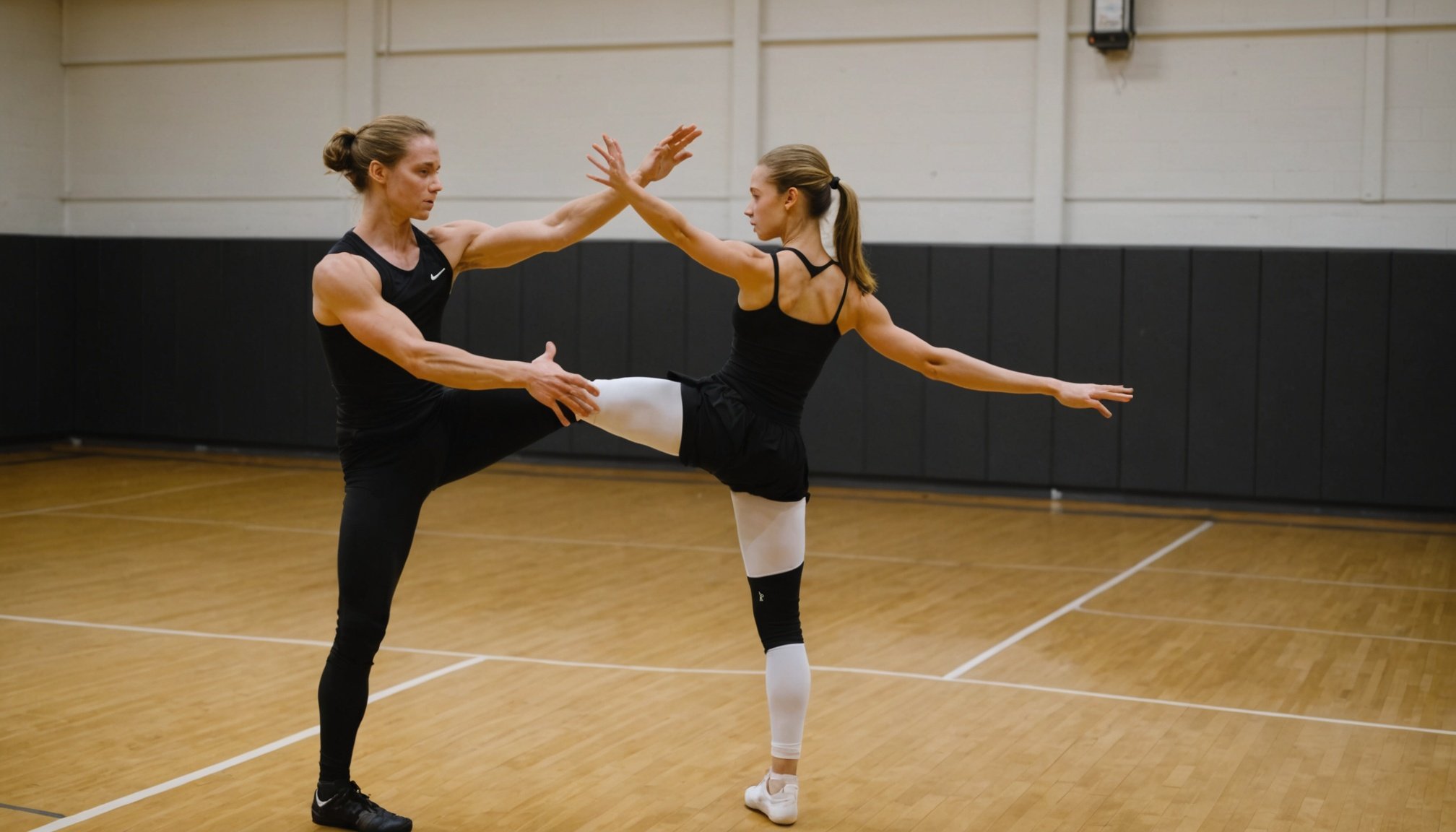Understanding Overuse Injuries in Dance
Overuse injuries are a significant concern in dance, impacting dance health and necessitating strategic injury prevention measures. These injuries result from repetitive stress on muscles and joints without adequate recovery time. Common types in dancers include tendinitis, stress fractures, and bursitis.
Several factors contribute to the prevalence of overuse injuries among dancers. These include the intense demands of dance training, insufficient rest periods, and improper conditioning strategies. Additionally, some dancers may ignore early pain signs, exacerbating potential injuries.
In the same genre : Maximizing athletic potential: exploring how wearable tech revolutionizes training and progress monitoring
If left untreated, overuse injuries can have severe consequences, hindering performance and potentially leading to chronic pain or lasting damage. Thus, it’s crucial for dancers to implement effective injury prevention techniques. This includes routines focusing on conditioning strategies that balance strength and flexibility, ensuring dancers can sustain their artistry without compromising their health.
Understanding the root causes and potential risks associated with overuse injuries allows dancers to take proactive steps in maintaining their overall physical well-being. By prioritising dancer wellness, individuals can enjoy a long and successful career in dance while minimising injury risks.
Also to discover : Empower your dance: the ultimate safe and effective strength training guide for dancers
Key Conditioning Strategies
Effective conditioning strategies are crucial in ensuring that dancers maintain optimal dance health and mitigate risks associated with overuse injuries. By adopting structured dance training exercises, dancers can enhance performance and safeguard against injury.
Warm-Up Techniques
Warm-up routines lay the foundation for a safe and productive dance session. Effective warm-up routines are integral in reducing the strain on muscles and joints. A balanced approach using both dynamic stretching and static stretching is recommended. Dynamic stretching, such as leg swings and arm circles, prepares the body for movement, while static stretching aids in muscle flexibility. Both methods craft a powerful synergy that supports injury prevention techniques.
Strength and Flexibility Routines
Focusing on strength and flexibility is essential for dance longevity. Strength exercises, such as planks and squats, build core stability, thereby reducing stress on joints. Moreover, targeted flexibility practices, like yoga, play a vital role in enhancing injury prevention. Balance between these routines promotes resilience and adaptability in a dancer’s body.
Cross-Training Approach
Cross-training is a beneficial practice for dancers seeking versatility. Incorporating activities like swimming or pilates can improve overall fitness and reduce repetitive strain from routine dance movements. By integrating cross-training into their schedules, dancers support comprehensive conditioning strategies, maintaining both performance quality and well-being.
Specific Preventive Measures
Rest and recovery are essential components of dance training and are crucial for sustaining long-term dancer wellness. Regular rest periods help the body repair itself, preventing the build-up of stress and strain that leads to overuse injuries. Adequate sleep and scheduled downtime allow muscles and tissues to heal, reducing the risk of injury significantly.
In addition to rest, nutrition plays a pivotal role in a dancer’s performance. A well-balanced diet rich in proteins, carbohydrates, and healthy fats fuels the body, ensuring dancers have the necessary energy reserves for rigorous routines. Integrating health tips such as consuming post-dance protein-rich snacks can aid muscle recovery.
Hydration is another cornerstone of effective preventive measures. Proper hydration maintains bodily functions and prevents dehydration, which can lead to fatigue and muscle cramps. A well-hydrated body is more resilient to injury and can sustain performance levels through intense dance training sessions.
By emphasising rest, nutrition, and hydration, dancers can enhance their overall performance and reduce injury risks, making these preventive measures integral to a dancer’s regimen.
Expert Insights on Injury Prevention
Gain a comprehensive understanding of injury management through insights from dance health specialists. Expert advice commonly emphasizes the role of physical therapy in both preventing and addressing overuse injuries. Renowned therapists advocate for personalized treatment plans that target individual dancer needs, promoting optimal recovery and enhanced physical therapy outcomes.
Interviews with dance health professionals reveal a growing trend towards integrating evidence-based practices into dance routines. Techniques such as proprioceptive training and neuromuscular exercises have been shown to effectively prevent injuries, while regular assessments allow for timely interventions.
Understanding the psychological aspects of dealing with injuries is equally crucial in the dance community. Injuries can often lead to emotional distress, impacting a dancer’s performance and motivation. Experts advise fostering a supportive environment where dancers feel comfortable discussing their challenges.
Evidence-based practices in psychotherapy, such as cognitive behavioural therapy, can assist dancers in coping with the mental hurdles of injury recovery. By prioritizing holistic care that addresses both physical and mental well-being, dancers can achieve a balanced approach to their long-term health. Through these expert insights, dancers are better equipped to manage and prevent injuries effectively.
Maintaining Overall Physical Health
Fostering a holistic approach to dancer fitness is vital for nurturing both the mind and body. Comprehensive attention to overall health ensures dancers remain resilient and adaptable throughout their careers. Psychological aspects can profoundly impact a dancer’s physical well-being, making mental health a priority. Techniques such as mindfulness and stress management effectively support the emotional demands of dance. Regular health check-ups, including screenings and consultations with specialists in sports medicine, enhance overall health by catching potential fitness issues early.
Here are some strategies to promote a balanced lifestyle:
- Encourage restful sleep and proper nutrition for sustained energy levels.
- Integrate stress-reducing practices like yoga or meditation to maintain mental clarity.
- Schedule periodic breaks from dance training to prevent burnout.
A balanced lifestyle not only prevents injury but also promotes dancer fitness, allowing performers to elevate their craft and sustain their passion over time. Addressing mental health and scheduling regular health check-ups create an environment where physical well-being flourishes, enabling dancers to thrive artistically and physically. In doing so, they achieve a harmonious integration of mind, body, and soul on and off the stage.
Visual Aids and Resources
In dance training, incorporating visual aids can significantly enhance understanding and execution of techniques, contributing to injury prevention and overall dance health. Educational resources, like videos and infographics, provide accessible and practical knowledge that dancers can easily integrate into their routines.
Demonstrative Videos
Demonstrative videos are invaluable for showing proper techniques and safe practices. They offer step-by-step guides, allowing dancers to visually grasp complex movements. Recommended tutorials often feature professional dancers or therapists demonstrating injury prevention techniques. These videos ensure dancers align their movements correctly, minimising the risk of overuse injuries.
Infographics on Injury Prevention
Infographics present essential information in a visual format, making it easier to digest. By illustrating key statistics related to overuse injuries, they highlight common pitfalls in dance practices. Graphs can display effective conditioning strategies, helping dancers balance strength, flexibility, and avoid injuries.
Additional Reading and Resources
For those seeking deeper insights, an array of credible articles and books on dance health and injury management are available. Access to works by renowned professional organizations ensures dancers have the necessary tools to prioritise safety in their practice, supporting sustained success in their careers.











